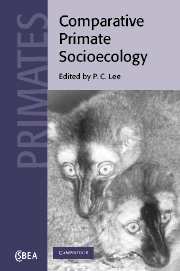Book contents
- Frontmatter
- Contents
- List of contributors
- Preface
- Part 1 Comparative methods
- Part 2 Comparative life history and biology
- Part 3 Comparative socioecology and social evolution
- 10 Lemur social structure and convergence in primate socioecology
- 11 Why is female kin bonding so rare? Comparative sociality of neotropical primates
- 12 Energetics, time budgets and group size
- 13 Ecology of sex differences in great ape foraging
- 14 Hominid behavioural evolution: missing links in comparative primate socioecology
- 15 Evolutionary ecology and cross-cultural comparison: the case of matrilineal descent in sub-Saharan Africa
- Editor's conclusion: Socioecology and social evolution
- Index
14 - Hominid behavioural evolution: missing links in comparative primate socioecology
Published online by Cambridge University Press: 24 August 2009
- Frontmatter
- Contents
- List of contributors
- Preface
- Part 1 Comparative methods
- Part 2 Comparative life history and biology
- Part 3 Comparative socioecology and social evolution
- 10 Lemur social structure and convergence in primate socioecology
- 11 Why is female kin bonding so rare? Comparative sociality of neotropical primates
- 12 Energetics, time budgets and group size
- 13 Ecology of sex differences in great ape foraging
- 14 Hominid behavioural evolution: missing links in comparative primate socioecology
- 15 Evolutionary ecology and cross-cultural comparison: the case of matrilineal descent in sub-Saharan Africa
- Editor's conclusion: Socioecology and social evolution
- Index
Summary
Introduction
Humans represent perhaps the greatest challenge to a comparative approach, for they comprise just one species, and one that is radically different from all others. However, the recognition of more and more species in the fossil record that are closer to humans than to other living primates has changed this perspective. The approximately 15 species of extinct hominid provide an excellent framework for considering hominid socioecology comparatively, and also for filling the gap between humans and chimpanzees and bonobos. The problem for a socioecological analysis is that we are entirely dependent upon the fossil record, with all that entails in terms of patchy and incomplete data, and total silence on a number of key issues relating to behaviour. Although there are technical and empirical problems is using fossil data, they do bring into focus some important issues that are often ignored in comparative analyses of extant species. Some of these will be addressed here in the context of human socioecological evolution.
Socioecology can be defined as the way in which ecological principles underlie the structure of behaviour and interactions between members of the same species, and reciprocally how social behaviour influences the exploitation of resources. That the observed ecological and social strategies of living species have thus evolved through natural selection, and represent adaptations to particular environments, is virtually axiomatic to the discipline. What is seldom made explicit, but follows from this, is that these small-scale adjustments provide the microevolutionary basis for long-term evolutionary change, and ultimately macroevolutionary patterns. Although the implications for long-term evolution are clear, for the most part socioecological analyses have not examined longer term evolutionary change.
- Type
- Chapter
- Information
- Comparative Primate Socioecology , pp. 363 - 386Publisher: Cambridge University PressPrint publication year: 1999
- 9
- Cited by

